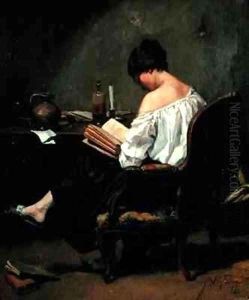Andre Fontaine Paintings
André Fontaine was a French artist known for his impressionist and post-impressionist style of painting. Born on April 20, 1869, in Bordeaux, France, Fontaine developed an early interest in the arts. He pursued his passion for painting and honed his skills, eventually becoming one of the many artists to contribute to the vibrant and evolving art scene in France at the turn of the 20th century.
Fontaine's work is characterized by a gentle use of color and a focus on light and its effects on the landscape and everyday scenes. He was greatly influenced by the impressionist movement, which emphasized capturing the momentary effects of light and color in paintings. Fontaine's choice of subjects often included urban scenes, rural landscapes, and interior views, demonstrating a versatility in his approach to composition and a keen eye for the beauty in the mundane.
Throughout his career, André Fontaine exhibited his work in various salons and galleries. He participated in the Salon des Artists Français, where he received recognition for his contributions to contemporary art. Despite the emergence of new art movements such as Fauvism and Cubism, Fontaine remained committed to his impressionistic style, evolving it subtly over time without abandoning its core principles.
Fontaine's paintings were appreciated for their tranquility and the sense of harmony they conveyed. He captured the essence of the French countryside with a delicate palette and fluid brushwork, which resonated with art collectors and enthusiasts of the period. His interiors and still-life paintings are particularly noted for their intimate portrayal of domestic life and the serene atmosphere they evoke.
André Fontaine continued to paint until his death on July 10, 1931, in Paris. Although he was not as widely known as some of his contemporaries like Claude Monet or Pierre-Auguste Renoir, his work remains a testament to the enduring appeal of impressionism and its influence on the course of modern art. Today, Fontaine's paintings can be found in private collections and occasionally appear in auctions, where they are valued for their contribution to the post-impressionist movement and their representation of a bygone era in French art.
